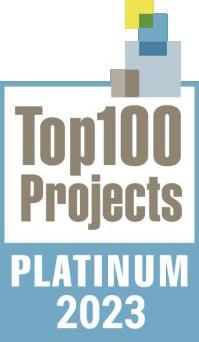
CONSTRUCTION ECONOMIST SUMMER 2023 The Journal of the Canadian Institute of Quantity Surveyors | Le Journal de l’Institut canadien des économistes en construction BRITISH COLUMBIA • PRAIRIES AND NORTHWEST TERRITORIES • ONTARIO • QUÉBEC• MARITIMES • NEWFOUNDLAND AND LABRADOR Canada’s Leading Journal in Construction Economics PM# 40787580 CANADIAN CONSTRUCTION MACROECONOMIC UPDATES
Sheila Lennon, CAE ceo@ciqs.org
Managing Editor Arif Ghaffur, PQS(F) aghaffur@ciqs.org
Assistant Editors Ajibola Soboyejo, PQS Shane McKernan, PQS
Send Change of Address to: memberservices@ciqs.org

Board of Directors
Chair: Arif Ghaffur, PQS(F)
Vice-Chair: Tammy Stockley, PQS(F)
Past Chair: Erin Brownlow, PQS(F)
Advisor: Roy Lewis, PQS(F)


Observer, International Relations: David Dooks, PQS(F)
Article Administration/

Author Liaison Kelsey Wright, Member Services Coordinator, CIQS memberservices@ciqs.org
Directors: Ajibola Soboyejo, PQS
Antoine Aurelis, PQS
Dominic Leadsom, PQS Ibrahim Oladapo, PQS
Kerry Mohur, PQS
Marc Brown, PQS Observer, YQS: Mykola Pulnyev, PQS
Statements of fact and opinion contained within this journal are those of the authors, including subject matter experts. CIQS assumes no responsibility or liability for the content of such fact and opinion, nor do they represent the official policy of CIQS.

Publisher Michael Bell michaelb@mediaedge.ca
Published four times a year on behalf of the Canadian Institute of Quantity Surveyors.



Published by: m ediaedgepublishing.co m
MediaEdge Publishing Inc. 33 South Station Street, North York, ON M9N 2B2 Toll-Free: 1-866-480-4717 ext. 229

531 Marion Street Winnipeg, MB Canada R2J 0J9 Toll Free: 1-866-201-3096

President Kevin Brown kevinb@mediaedge.ca
Senior Vice-President Robert Thompson robertt@mediaedge.ca
Fax: 204-480-4420 www.mediaedgepublishing.com
Director, Business Development Michael Bell michaelb@mediaedge.ca
Branch Manager Nancie Privé nanciep@mediaedgepublishing.com
The mission of CIQS is to promote and advance professional quantity surveying and construction estimating; to establish and maintain national standards; to recruit, educate and support our members. Canadian Institute of Quantity Surveyors 90 Nolan Court, Unit 19, Markham, ON L3R 4L9 t. 905/477.0008 f. 905/477.6774 toll free. +1 866/345.1168 info@ciqs.org www.ciqs.org www.ciqs.org/congress CONSTRUCTION ECONOMIST The Journal of the Canadian Institute of Quantity Surveyors Le Journal de l’Institut canadien des économistes en construction SUMMER 2023 Features Canadian Construction Indicators of Growth, Composition and Changes 8 The Climate Policies in Canada: Buildings and the Net Zero Accountability Act 12 CIQS’s Role in the Contract Security Improvement Working Group 18 Collaborative Behavioural Assessments The Emerging Norm ................................................................... 19 In Memoriam 22 Corners Education Corner............... 10 Prompt Payment Corner .... 14 Congratulations Corner ..... 15 Young Quantity Surveyor Corner ................ 17 Messages Chair’s Message. 4 CEO’s Message. 6 Download Media Planner PLEASE RETURN UNDELIVERABLE COPIES TO: CIQS Canadian Institute of Quantity Surveyors 90 Nolan Court, Unit 19 Markham, ON L3R 4L9 PUBLICATION MAIL AGREEMENT #40787580 CIQS Editorial Team
Executive Officer
Chief
REMAINING CURRENT AND RELEVANT
CIQS Drives on All Fronts
Recognizing the backdrop of the current strategic plan covering the period 2022 to 2025, the CIQS Board continues to work closely with the office of the Chief Executive Officer as it progresses its role in establishing strategy, providing oversight and governance consistent with its mandate. In contrast to its previous role as a management board, the CIQS Board is now a strategic board providing expertise to the CEO’s office, which is responsible for the ongoing management of CIQS business.
Within this remit, the CIQS Board meets regularly with a continuing focus to support chapters, enhance education initiatives, consolidate on external relations, support the CIQS, further engage members and push forward governance, ethics, and conduct initiatives; this focus being parallel with pushing forward important initiatives such as around risk management, value proposition, prompt payment, and extended outreach via the ambassador program.
By very nature, the CIQS is a multifaceted, geographically diverse, and multipronged professional association that is growing in an increasingly complex ecosystem of multiple stakeholders that directly impact its operational efficiency. This ecosystem includes aspiring members, members, senior professionals, volunteers (including the CIQS Board), government of all levels, third party service providers, employer organizations, other professional bodies, trade associations and others that often interface or take an interest in the CIQS.
At the core of CIQS success is the need to strike long-lasting relationships and building trust with all who interface with the Institute such that the association remains current and relevant. These relationships require ongoing meetings, exchanges, knowledge sharing, conversations, exploring ideas, and engaging in open-minded dialogue that is for the “Good of the Institute including its Members”. The ethos of perpetual engagement remains at the core of CIQS success.
While this process of interaction can bring out differences in opinions and thought processes, it serves as fertile ground for the growth of new and progressive ideas that promote growth of the CIQS. In my capacity as CIQS Chair, I continue to encourage such interactions and see these as positive pre-cursors to building long-term relationships and trust.
Following are quotes from some of those who continue to volunteer their time and effort for the benefit, and the advancement, of our profession:
RESTER D’ACTUALITÉ ET PERTINENT
L’ICÉC mène sur tous les fronts
• Roy Lewis PQS(F), Advisor to the CIQS Board:




“The CIQS Board is continuing to progress an agenda that recognizes the diverse employee set of our members which include consultancies, general contractors and trade contractors.”
• David Dooks PQS (F), Observer, International Relations:
“It is pleasing to see the support of the CIQS Board to maintain and build relationships with our international partners, including those countries with which we have reciprocity agreements.”
• Ajibola Soboyejo, PQS, Director:
“My continuing role on the CIQS Board has provided me the opportunity to actively contribute to all aspects of strategy, oversight and governance across the whole spectrum of the CIQS.”
• Mykola Pulnyev PQS, Observer, Young Quantity Surveyors:
“The focus and support of the CIQS Board in progressing initiatives for the growth of the YQS will ensure that we will have a pipeline of professionals providing the coveted designations of CEC and PQS.”
Despite the sterling efforts of the CIQS Board and the CEO’s office, it remains incumbent upon the members to uphold the profession. In digging through the archives , it is interesting to note that at the 1st AGM of the CIQS in April 1960, the then President (Malcolm Milton) stated that “Having called ourselves Quantity Surveyors, it is up to every member of the Institute to ensure that the name is held in respect …”.
In closing, I would like to take this opportunity to thank Chris Court PQS(F), the outgoing Editor of the Construction Economist who delivered this role as I transitioned into the CIQS Chair role. will now continue to support the journal as its Managing Editor, as we work with our new publishers to elevate the Construction Economist to the journal of choice for Construction Economists in Canada.
Respectfully submitted, Arif Ghaffur
PQS (F), Chair, CIQS
Dans le contexte du plan stratégique actuel qui couvre la période de 2022 à 2025 le conseil d’administration de l’ICÉC continue de travailler en étroite collaboration avec le bureau du directeur général dans le cadre de son rôle d’établissement de la stratégie, de supervision et de gouvernance, conformément à son mandat. Contrairement à son rôle antérieur de conseil de gestion, le conseil d’administration de l’ICÉC est désormais un conseil stratégique qui apporte son expertise au bureau du directeur général, qui est responsable de la gestion courante des activités de l’ICÉC.
Dans le cadre de cette mission, le conseil d’administration de l’ICÉC se réunit régulièrement et continue de soutenir les chapitres, d’améliorer les initiatives en matière de formation, de consolider les relations extérieures, de soutenir l’ICÉC, d’impliquer davantage les membres et de faire avancer les initiatives en matière de gouvernance, d’éthique et de conduite. Cet objectif est mis en œuvre parallèlement à des initiatives importantes telles que la gestion des risques, la proposition de valeur, le paiement rapide et la sensibilisation par le biais du programme des ambassadeurs.
Par nature, l’ICÉC est une association professionnelle à multiples facettes, géographiquement diversifiée, qui se développe dans un écosystème de plus en plus complexe de parties prenantes multiples qui ont des répercussions directes sur son efficacité opérationnelle. Cet écosystème comprend les candidats au statut de membre, les membres, les professionnels à la retraite, les bénévoles (y compris le conseil d’administration de l’ICÉC), les gouvernements à tous les niveaux, les fournisseurs de services tiers, les organisations d’employeurs, les autres organismes professionnels, les associations commerciales et d’autres qui sont souvent en contact avec l’ICÉC ou qui s’y intéressent.
Au cœur de la réussite de l’ICÉC se trouve la nécessité de nouer des relations durables et d’instaurer un climat de confiance avec tous ceux qui sont en contact avec l’Institut, afin que l’association reste d’actualité et pertinente. Ces relations nécessitent des réunions, des échanges, un partage des connaissances, des conversations, l’exploration d’idées et l’engagement dans un dialogue ouvert d’esprit pour le « bien de l’Institut et de ses membres ». L’éthique de l’engagement perpétuel reste au cœur du succès de l’ICÉC.
Bien que ce processus d’interaction puisse faire apparaître des divergences en matière d’opinions et de processus de pensée, il sert de terrain fertile pour la croissance d’idées nouvelles et progressistes qui favorisent la croissance de l’ICÉC. En ma qualité de président de l’ICÉC, je continue d’encourager de telles interactions, que je considère comme des précurseurs positifs pour l’établissement de relations et d’une confiance sur le long terme. Voici quelques citations de ceux qui continuent à consacrer bénévolement leur temps et leurs efforts pour soutenir et promouvoir notre profession :
• Roy Lewis, ÉCA(F), conseiller auprès du conseil d’administration de l’ICÉC :
« Le conseil d’administration de l’ICÉC continue à faire avancer un programme qui reconnaît la diversité des statuts professionnels de nos membres, qui comprennent des consultants, des entrepreneurs généraux et des entrepreneurs spécialisés. »


• David Dooks ÉCA(F), observateur, relations internationales :
« Je suis ravi de voir les efforts que le conseil d’administration de l’ICÉC met en place pour maintenir et construire des relations avec nos partenaires internationaux, y compris les pays avec lesquels nous avons des accords de réciprocité. »
• Ajibola Soboyejo, ÉCA, administratrice :
« Mon rôle de longue date au sein du conseil d’administration de l’ICÉC m’a donné l’occasion de contribuer activement à tous les aspects de la stratégie, de la supervision et de la gouvernance dans l’ensemble de l’éventail de l’ICÉC. »
• Mykola Pulnyev ÉCA, observateur, Young Quantity Surveyors :


« Grâce à l’attention et au soutien du conseil d’administration de l’ICÉC au niveau de la mise en œuvre d’initiatives visant à développer le programme YQS, nous disposons d’un vivier de professionnels capables d’obtenir les titres convoités d’ECC et d’ÉCA. »
Malgré les efforts remarquables du conseil d’administration de l’ICÉC et du bureau du directeur général, il incombe toujours aux membres de défendre la profession. Si on se tourne vers les archives , il est intéressant de noter que, lors de la première AGA de l’ICÉC en avril 1960, le président de l’époque (Malcolm Milton) avait déclaré : « Puisque nous avons choisi le nom d’économistes en construction, il incombe à chaque membre de l’Institut de veiller à ce que ce nom soit respecté… ».
Pour conclure, j’aimerais profiter de l’occasion pour remercier Chris Court ÉCA(F), le rédacteur en chef sortant du Construction Economist, qui a assumé ce rôle au cours de ma transition dans le rôle de président de l’ICÉC. À présent, je continuerai à soutenir la revue en tant que rédacteur en chef et nous collaborerons avec nos nouveaux éditeurs pour faire du Construction Economist la revue de prédilection des économistes en construction au Canada.
Salutations respectueuses, Arif Ghaffur, ÉCA (F), Président, ICÉC


www.ciqs.org SUMMER 2023 | CONSTRUCTION ECONOMIST 5 4 CONSTRUCTION ECONOMIST | SUMMER 2023 www.ciqs.org
Chair’s Message Chair’s Message
Arif Ghaffur, PQS(F)
Arif Ghaffur, PQS(F)
1 Page 31 de la version anglaise de l’histoire de l’Institut canadien des économistes en construction (1959-2009)
1 Page 31, History of the Canadian Institute of Quantity Surveyors (1959-2009)
IF WE BUILD IT, THEY WILL LOG ON SI NOUS LE CONSTRUISONS, ILS S’Y CONNECTERONT
Sheila Lennon, CAE | Chief Executive Officer, CIQS
As I was contemplating what to write about in this issue’s Message from the CEO, I flipped through past issues of the Construction Economist and came across an article where we announced our new association management system (AMS) and how it would revolutionize how we conduct business and communicate with our members.
Fast forward two years, and I am excited to see how the new system has streamlined a multitude of processes across every department at the CIQS. From a staff perspective, it has helped to automate certain administrative tasks, which has in turn allowed them to focus more of their time on member relations, training, and growth.
From a member perspective, the AMS has offered them the freedom to independently update their member accounts, pay for events and membership renewals, view their payment history, and select how they communicate with the CIQS, when they want, from wherever they want.
Building an online community
When we made the decision to move to this online membership portal, we wanted to create a central hub for our members that would offer the benefits listed above as well as a platform where they can record and track their CPD points, access learning opportunities, and participate in online discussion forums.
This new, interactive portal is designed to function similarly to a social media platform, where members can customize their profile account by uploading a photo and adding their bio and social media handles. The idea behind this design is to make it as user-friendly as possible for members to ensure their account, membership status, contact information, and communications preferences are always up to date.
Coming in 2023
Discussion Forums: Staff are currently building discussion forums that can be accessed by members through the AMS. Set to be our pilot, a YQS Program Forum is scheduled to be launched, later this year. The design and launch of other forums will be based on the statistics gathered from the pilot.
LMS: We are in the final setup of a new Learning Management System (LMS), scheduled to be online in late summer. Members will then be able to log into their online account with access to webinars and other learning sources required for their CPD, or to view, submit, and track the TPE requirements to earn their CIQS designation.
Online CPD Tracker: The CIQS CPD program is a formal way of tracking and documenting a member’s professional development, as it relates to their profession and their CIQS designation, in a less rigid format than formal academic training. Beginning later this year, members will be able to record and track all CPD-eligible activities directly within their profile on the CIQS membership portal.
Starting in the 2024–2025 membership year, members must complete their minimum required 50 CPD points to be eligible to renew their membership, and to continue the right to use their designation. It is therefore highly recommended that all PQS and CEC members maintain detailed records of all CPD-eligible activities from January 1, 2023, onwards, to be recorded in the AMS as soon as the new CPD module has been launched.
There is a myriad of ways to earn 50 CPD points annually.
1. Attend the CIQS Congress and earn close to 25% of your annual requirement.
2. Listen to the CIQS podcast, “Knowledge Counts”; earn one CPD point per episode.
3. Attend national and regional events and webinars; earn between one and three points depending on the event/webinar.
4. Participate on CIQS, or other industry-related, boards and committees.
5. Present at eligible conferences, workshops, and meetings.
6. Publish articles or white papers in industry-related publications such as the Construction Economist
Make the most of your membership
No matter what your reason for logging into your online member account, we ask that you do so often to ensure you are keeping your personal information current, and that you are taking advantage of all the benefits your membership offers.
Sheila Lennon, CAE | Chief Executive Officer, CIQS


En éfléchissant à ce que j’allais écrire dans le Message de la directrice générale de ce numéro, j’ai feuilleté les anciens numéros du Construction Economist et je suis tombée sur un article dans lequel nous annoncions notre nouveau système de gestion associative et la manière dont il allait révolutionner la façon dont nous menons nos activités et communiquons avec nos membres.
Deux ans plus tard, je suis ravie de constater que le nouveau système a permis de rationaliser une multitude de processus au niveau de tous les services de l’ICÉC. Du point de vue du personnel, il a contribué à automatiser certaines tâches administratives, permettant ainsi à nos employés de consacrer plus de temps aux relations avec les membres, à la formation et à la croissance.
Du point de vue des membres, il leur a offert la liberté de mettre à jour de manière indépendante leur compte de membre, de payer pour les événements et le renouvellement de leur adhésion, de consulter l’historique de leurs paiements et de choisir la manière dont ils communiquent avec l’ICÉC, au moment et depuis l’endroit qui leur conviennent le mieux.
Création d’une communauté en ligne
Lorsque nous avons pris la décision de passer à ce portail d’adhésion en ligne, nous voulions créer une plate-forme centrale pour nos membres qui offrirait les avantages énumérés ci-dessus tout en leur permettant d’enregistrer et suivre leurs points de DPC, d’accéder à des opportunités d’apprentissage et de participer à des forums de discussion en ligne.
Ce nouveau portail interactif est conçu pour fonctionner comme une plate-forme de médias sociaux, où les membres peuvent personnaliser leur compte de profil en téléversant une photo et en ajoutant leur biographie et leurs adresses de médias sociaux. L’idée sous-jacente est de rendre le processus aussi convivial que possible pour les membres afin de s’assurer que leur compte, leur statut de membre, leurs coordonnées et leurs préférences en matière de communication sont toujours à jour.
À venir en 2023
Forums de discussion : Le personnel met actuellement en place des forums de discussion auxquels les membres peuvent accéder par l’intermédiaire du système de gestion associative. Le Forum du programme YQS, qui sera notre projet pilote, devrait être lancé dans le courant de l’année. La conception et le lancement d’autres forums utiliseront les statistiques recueillies dans le cadre du projet pilote.
Système de gestion de l’apprentissage : Nous sommes en train de finaliser la mise en place d’un nouveau système de gestion de l’apprentissage, dont la mise en ligne est prévue pour la fin de l’été. Les membres pourront alors se connecter à leur compte en ligne et accéder aux webinaires et autres sources d’apprentissage nécessaires à leur DPC, ou consulter, soumettre et suivre les exigences en matière de TEP pour obtenir un des titres de l’ICÉC.
Suivi du DPC en ligne : Le programme de DPC de l’ICÉC est un moyen formel de suivre et de documenter le développement professionnel d’un membre, dans la mesure où il est lié à sa profession et à son titre de l’ICÉC, dans un format moins rigide qu’une formation académique formelle. À partir de cette année, les membres pourront enregistrer et suivre toutes les activités admissibles pour le DPC directement dans leur profil sur le portail des membres de l’ICÉC.
À partir de l’année d’adhésion 2024-2025, les membres devront obtenir le minimum requis de 50 points de DPC pour pouvoir renouveler leur adhésion et conserver le droit d’utiliser leur titre. Il est donc fortement recommandé à tous les membres ÉCA et ECC de tenir des registres détaillés de toutes les activités éligibles pour le DPC à partir du 1er janvier 2023, afin de les enregistrer dans le système de gestion associative dès le lancement du nouveau module de DPC.
Il existe de nombreuses façons d’obtenir 50 points de DPC par an.
1. Participez au congrès de l’ICÉC pour obtenir près de 25 % du total annuel exigé.
2. Écoutez le balado de l’ICÉC, « Knowledge Counts » et obtenez un point DPC par épisode.
3. Participez à des événements nationaux et régionaux et à des webinaires et obtenez entre un et trois points en fonction de l’événement/webinaire.
4. Participez aux conseils et comités de l’ICÉC ou d’autres organismes liés à l’industrie.
5. Présentez des exposés lors de conférences, d’ateliers et de réunions admissibles.
6. Publiez des articles ou des livres blancs dans des publications liées au secteur, telles que le Construction Economist.
Profitez au mieux de votre adhésion
Quelle que soit la raison de votre connexion, veuillez vous connecter régulièrement à votre compte de membre en ligne, afin de vous assurer que vos renseignements personnels sont à jour et que vous profitez de tous les avantages offerts par votre adhésion.
www.ciqs.org SUMMER 2023 | CONSTRUCTION ECONOMIST 7 6 CONSTRUCTION ECONOMIST | SUMMER 2023 www.ciqs.org
CEO’s Message CEO’s Message
CANADIAN CONSTRUCTION
- Indicators of Growth, Composition and Changes
Recent data on the Canadian Construction Industry performance indicators provide insights into resilience of the industry, overall construction price trends, and the industry’s response to housing supply concerns in Canada.
Construction Industry GDP and Investments
Despite economy-related concerns, the construction industry in Canada is showing signs of promise in the first quarter of 2023. A relative year-over-year increase of 0.6% in GDP indicates a positive outlook for the industry. According to Stats Canada, the construction sector expanded by 0.3% in February, marking the second consecutive increase at the beginning of the year, following a decline in the last five months of 2022.
However, data shows some concerns about investments in residential construction within the industry. Investment in residential construction decreased by 0.5% over the past year and has experienced only a slight increase of 1% from the previous month. Nonetheless, non-residential construction saw a yearly increase of 10%. Statistics Canada attributes this growth to the 15th consecutive monthly increase in industrial construction investment, excluding Newfoundland and Labrador.
Overall, Canada’s construction industry is making positive strides, particularly in non-residential construction. These trends and statistics demonstrate the resilience and adaptability of the construction industry, and it will be interesting to monitor its progress as the year continues amid the looming recession.
Housing Starts
The housing starts trend in 2023 started on a downward trajectory at the beginning of the year, experiencing a decline of 3% in the first quarter compared to the previous year and decrease of 31% from the last quarter. This decline indicates a correlation between investment in residential construction and housing starts in Canada, as both data points show a year-over-year decline. It is worth noting that housing starts in the first quarter are typically lower than the second, third, and last quarters each year.
According to the Canada Mortgage and Housing Corporation (CMHC), among the three major metropolitan cities - Vancouver, Toronto, and Montréal - only Vancouver recorded an increase in the total seasonally adjusted annual rate of housing starts in March, with a notable 98% rise due to more than twice as many multi-units starts compared to February. Conversely, Montréal and Toronto experienced 12% and 26% declines, respectively.

The decline in housing starts reflects a lack of effective response to the pressing need for increased housing supply to address the housing affordability issue in the country. It is clear that it will
take time for the housing supply to catch up with the continuously growing population in Canada. That said, the implications of this situation for the construction industry are uncertain, and only time will reveal the outcome.
Building Construction Price Index
In the first quarter of 2023, construction prices for residential and non-residential construction in the 11-city index experienced yearover-year increases of 11.1% and 9.6%, respectively; however, compared to the previous quarter, there was a relative increase of 1.8% and 1.7% in residential and non-residential building construction costs.

Toronto led the residential construction price index chart with a score of 188.5, marking a significant increase of 17.7% from Q1 2022. Calgary and Ottawa followed closely with indices of 174.8 and 173.1, respectively, experiencing a relative increase of 6% from the previous year. The construction cost upsurge in Calgary and Edmonton seems to be gradually stabilizing, with a decrease in the year-over-year increase from around 7% in Q1 2022 to 6% in Q1 2023 and a slight decline in the construction price index by -0.4% in the last quarter. However, Toronto’s residential construction prices have noticeably surged in the first quarter of 2023, attracting significant attention. According to Stats Canada, construction costs for residential buildings increased the most in Toronto (+3.2%) in the last quarter.
Generally, the residential construction price index was higher than the non-residential construction price index, except in Montreal and Moncton, whereas the most significant increases in non-residential construction costs were in Ottawa, Toronto, Montreal, and Moncton. Notably, Moncton had the highest year-over-year increase of 14.2%, bringing its non-residential construction price index closer to residential construction. In the last quarter alone, Vancouver and Moncton saw a 2.3% increase in non-residential construction costs.
These trends indicate that construction prices are rising in residential and non-residential sectors, with certain cities experiencing significant increases.
Employment in the Canadian Construction Industry
As of April 2023, the employment composition within the construction industry continues to display a significant gender gap. The workforce remains predominantly male, with males accounting for 86% of the industry’s employment. This stark contrast highlights the ongoing imbalance in gender representation within the construction sector. In comparison, the distribution of the total working population in Canada shows a more even split between genders.



*Based on available data from Statistics Canada as on May 10, 2023, as follows:
1. Growth in Construction Industry Gross Domestic Product (GDP), as at Feb 2023: Statistics Canada. Table 36-10-0434-01 Gross domestic product (GDP) at basic prices, by industry, monthly (x 1,000,000)
2. Composition & Changes in Investments in Construction, as at Feb 2023: Statistics Canada. Table 34-10-0175-01 Investment in Building Construction
3. Construction Price Index Across Metropolises, as at Q1 2023: Statistics Canada. Table 18-10-0276-01 Building construction price indexes, by type of building
4. Housing Starts Composition, as at Q1 2023 (Residential Construction): Statistics Canada. Table 34-10-0135-01 Canada Mortgage and Housing Corporation, housing starts, under construction and completions, all areas, quarterly
5. Changes in Housing Starts, as at Q1 2023: Statistics Canada. Table 34-10-0135-01 Canada Mortgage and Housing Corporation, housing starts, under construction and completions, all areas, quarterly

6. Composition of Employment in All Industries Vs Construction, as at April 2023: Statistics Canada. Table 14-10-0022-01 Labour force characteristics by industry, monthly, unadjusted for seasonality (x 1,000)
About the Author
Ajibola Soboyejo, MSc, MRICS, PQS Senior Consultant, Altus Group Ajibola is a professional quantity surveyor specializing in cost planning, design economics, BIM estimating, cost control, and project management. Ajibola possesses both Master’s and Bachelor’s degrees in Quantity Surveying and has worked on series of commercial real estate projects in Nigeria and Canada.

Udayan Chatterjee, B.Tech, PMP, MRICS, PMI-SP Associate Director, Contracts & Commercial, Lakeland Consulting Inc. Udayan is a commercial and project management professional with expertise in quantum assessment, schedule forensics, contract and claims management. He holds a Bachelor’s degree in Electrical Engineering and has worked on various large scale transportation, mining and commercial construction projects across Canada and India.

www.ciqs.org SUMMER 2023 | CONSTRUCTION ECONOMIST 9 8 CONSTRUCTION ECONOMIST | SUMMER 2023 www.ciqs.org Macroeconomic Macroeconomic
“WHO READS BOOKS?”: The case for CIQS Publications
PROJECT PROFILE – CURV
Project: Curv Location: Vancouver, BC
Owner/Developer: Brivia Group
 Shane McKernan, PQS, GSC, B.Tech
Shane McKernan, PQS, GSC, B.Tech

Many of us know that the CIQS has an online bookstore where there are around 10 highly valuable books available, all published by the CIQS. But in the age of YouTube videos and ChatGPT, one might wonder what point there is in continuing to have a professional library.
In fact, one of the missions for our education committee was to explore the needs for developing and updating technical publications that reflect the latest industry trends and practices. Whether you’re a seasoned practitioner or a student just starting out, as a published author myself, I can testify CIQS books offer a wealth of knowledge and insights that can help you stay ahead of the curve and excel in your career. For example, I will quickly just name a few:
• Elemental Cost Analysis: My personal favorite due to its abundant illustrative sketches identifying the building elements in a systematic approach. This manual also includes guidance on measuring gross floor area (GFA), which answers many questions raised by people from outside the QS profession.

• Method of Measurement of Construction Works: Canadian standard “rules of measurement”. This guide follows the structure of project spec sections and matches the MasterFormat system, which is widely understood by almost everyone in the building construction industry.

• Construction Project Development: The latest addition to CIQS collections and the largest book so far. Starting with the economics of construction project development, and ending with the practice of project loan monitoring, this 900-page book can serve as an invaluable resource for both professionals and learners.
For the book format, probably nothing beats the feeling of having a tangible, physical book, staying focused and able to crossreference contents conveniently, instead of staring at a screen all day and scrambling desperately to find a detail—those who work with PDF drawings know what I mean—however, I acknowledge reading habits are still an issue of personal preference and thus open to further discussion. The quarterly journal Construction Economist you are reading now is also available in print and digital form, with a range of technical articles and case studies written by our Canadian QS experts.
Another benefit provided by CIQS publications is the knowledge transfer from experienced professionals to the younger generation, which is incredibly relevant today with the skilled labour shortage problem. One of my engineer friends used to say: “Whatever we do in this world, we will leave some footprints behind us and that is how we will be judged”. CIQS published books are the accumulated wealth of expertise of quantity surveyors spanning several generations.
If you have the desire to share your knowledge and experience, feel free to join our education committee and get involved in some upcoming CIQS publication projects. While my 3-year term of education director is up, our committee group consisting of many highly intelligent and motivated individuals is always here to serve the institute and members. The next exciting CIQS book is already on the horizon—so stay tuned and connected!
Stats:
• Built at 1075 Nelson Street between Thurlow and Burrard Street, downtown Vancouver.
• One tower, that will weigh in at 60 stories, or ~175 metres.
• 358 market condominiums.
• 143 social + market rental condominiums.

• Tallest Passive House in the world.
• Tallest residential tower in Vancouver.
• First North American projects for British architect Tom Wright (WKK Architects – who designed the 312-meter Burj al Arab building in Dubai).
CURV, set for construction next year, will be located in the pinnacle of downtown Vancouver with a total of 501 units. There will be a mix of social and market rentals on the lower floors (up to the 20th floor), and 358 luxury condos for sale on the upper floors. This marks Montreal based developer Brivia Group’s first Vancouver project. Brivia group is behind the tallest residential tower in Montreal, 1Square Philips.
Part of Vancouver’s ongoing goal of becoming the greenest city in the world, CURV positions itself in Vancouver’s skyline as the soon to be tallest Passive House tower in the world. The international Passive House standard, which draws heavily from German and Canadian engineering, has gained worldwide recognition as the most advanced building standard for creating healthy and energy-efficient homes. To meet the rigorous criteria of the Passive House standard, a dwelling must achieve an impressive 90% reduction in energy consumption compared to traditional buildings. This entails strict adherence to specific requirements regarding the amount of energy used for space heating, cooling, and overall primary energy demands, measured in watt-hours. By incorporating super-insulation and ventilation, it significantly reduces the need for heating and cooling energy, surpassing the City of Vancouver’s 2030 targets for net-zero-ready emissions. With its carbon-conscious design, tranquil ambiance, and emphasis on health, CURV is meticulously engineered to provide the highest level of performance while maintaining affordable long-term costs.
As one would anticipate from a top-tier, environmentally conscious development, the amenities provided will set new benchmarks for luxury standards. The centerpiece will be the tallest clubhouse in western Canada, spanning the 60th and 61st floors, offering 360 panoramic views of Vancouver from every angle. Additionally, these amenities include a fully equipped fitness center, a dedicated yoga studio, a spacious rooftop terrace with panoramic views, a luxurious “sky spa” for relaxation, and an outdoor cinema for entertainment purposes. Throughout the lower levels, carefully designed spaces for social gatherings and children will be integrated, emphasizing walkability.
About the Author
Shane is the Director of Construction for Chard Development, based in Vancouver, British Columbia. With over sixteen years of experience in the construction sector, Shane’s experience includes estimating, cost consulting, project loan monitoring, and project & construction management. Shane is the current Past-President of the CIQS – BC Chapter, where he joined as the board’s first-ever student member in 2013. Shane also previously sat on the CIQS National Council as the YQS Observer for two terms and is an Assistant to the Construction Economist editor.
www.ciqs.org SUMMER 2023 | CONSTRUCTION ECONOMIST 11 10 CONSTRUCTION ECONOMIST | SUMMER 2023 www.ciqs.org Education Corner
Adam Ding, PQS(F)
Project Profile
Climate Policies in Canada: BUILDINGS AND THE NET ZERO ACCOUNTABILITY ACT

On May 6, 2023, Alberta’s Premier, Danielle Smith declared a State of Emergency in response to massive wildfires raging across the province. Nearly 30,000 Albertans have been displaced from their homes, and there have been 108 active wildfires in 2023 alone. So far this year, neighboring Saskatchewan has had 85 active wildfires—almost double the 5-year running average. As our climate continues to change, the risk of wildfires are expected to increase. The Sixth Assessment Report (AR6) on climate change was released by the United Nations’ Intergovernmental Panel on Climate Change (IPCC) in March 2023. In the AR6, the IPCC reiterated that increased wildfires, mass mortality of trees, drying of peatlands, and permafrost thawing, etc., are increasing risks from overshooting the 1.5oC warming threshold established at the 2015 Paris Climate Convention.

Canada is warming twice as fast as the global average. Wildfires in Canada are already becoming more frequent, 12% of the country’s land area is peatland, and permafrost underlies 40-50% of Canada. These and more make a strong climate policy essential for Canada, in the global effort against climate change.
The Net Zero Emissions Accountability Act (the Act) received Royal Assent in 2021, and it is Canada’s national governing policy for climate action. It commits Canada to reduce greenhouse gas (GHG) emissions by 40-45 percent below 2005 levels by 2030, and achieve net zero GHG emissions by 2050, through defined frameworks for accountability and transparency. In 2022, the federal government released the framework for the 2030 goal, as required by the Act, in the 2030 Emissions Reduction Plan (the Plan) based on ‘best available science’.1. Buildings, which account for over 13% of Canada’s emissions, is a major sector targeted for GHG reduction in Canada. Accounting for purchased electricity used in buildings brings the share of emissions from the sector to 19% or almost one-fifth of total emissions. Figure 1 shows a breakdown of Canada’s emissions by economic sector based on most recent 2021 data2, when Canada’s total emissions were recorded at 670 Mt CO2 eq. By 2030, according to projections in the Plan, building sector emissions should lower to around 53 Mt CO2 eq, a 39% reduction from the 2021 reported data.
The Federal Greening Government Strategies.
The federal government took the lead in decarbonizing its building footprint with its Greening Government Strategy (GGS), which highlights government’s commitments to real property decarbonization3. Investment decisions for major upgrades,
Figure 2: Breakdown of Canada’s greenhouse gas emissions by economic sector (2021). Canada aims to reduce total emissions to around 443 Mt CO2e by 2030. Data source: Environment and Climate Change Canada.

retrofit and new construction by government departments will be based on optimizing total cost of ownership, rather than the just the initial acquisition cost considerations. This approach prioritizes low emissions strategies as well as climate resilience opportunity for real properties. Some examples of low emissions strategies for existing building retrofits include adoption of energy metering, switching to clean/renewable electricity where available, recommissioning, heat pumps or high efficiency HVAC upgrade, etc. These strategies can lower carbon emitted through operations of buildings. These types of emissions are known as operational carbon.
In addition to operational carbon, the construction of new buildings also adds another type of emission known as embodied carbon to the environment. Embodied carbon refers to the carbon locked into the materials used in building construction. Mass timber buildings have risen in popularity as they have lower embodied carbon than steel and concrete, plus the added benefit of carbon sequestration. In 2022, the federal government’s Policy on Green Procurement adopted a new ‘Standard on Embodied Carbon in Construction’. This standard requires embodied emission disclosures for concrete used in new construction valued above $10million. The International Cost Management Standard, 3rd Edition (ICMS 3) also provides a framework for reporting carbon emissions from buildings and construction activities.
Centre Block Rehabilitation. The $5B rehabilitation project for Canada’s icon of democracy, the Centre Block, approved in 2021, is the largest heritage rehabilitation project of its kind in Canada.

The project is scheduled for completion in 2030, same target year as the current emission reduction plan. It is a complex project which seeks to balance heritage restoration with decarbonization goals in line with the requirements of the Plan and the Act. To achieve these goals, the project is pursuing the Leadership in Energy and Environmental Design (LEED) Certification, a globally recognized green building certification program for buildings that meets applicable sustainable design, construction, and operations standards. If LEED certification is achieved, the building will be positioned to help reduce greenhouse gas emissions and contribute to Canada’s 2050 commitments.
Coming Next
The next part of this series will examine case studies of how the Net Zero Emissions Accountability Act and the 2030 Plan are shaping building investments for institutional and commercial properties in Canada.
Further Reading
Environment and Climate Change Canada. (2022). 2030 Emissions Reduction Plan: Clean Air, Strong Economy.
References
[1] Government of Canada. (2022). Canadian Net-Zero Emissions Accountability Act. Last assessed May 9, 2023, via https://www. canada.ca/en/services/environment/weather/climatechange/ climate-plan/net-zero-emissions-2050/canadian-net-zeroemissions-accountability-act.html
[2] Environment and Climate Change Canada. (2023). National inventory report 1990-2021: Greenhouse gas sources and sinks in Canada. Ottawa. Published, 2023.
[3] Treasury Board of Canada. (2022). Greening Government Strategy: A Government of Canada Directive. Last assessed May 9, 2023, via https://www.canada.ca/en/treasury-board-
About the Author
Ayo Daniel Abiola, PQS is the President of Avalanche Nation Services Inc., and an Independent Consultant offering cost consulting, facility assessment, and appraisals for Industrial, Commercial, and Institutional (ICI) properties in the Prairies, and across Canada.
Ayo is licensed to practise engineering in Ontario and Saskatchewan. He is also a Certified Energy Manager and a WELL Accredited Professional, having the skills and experience to foster health and wellness in the built environment.
Ayo lives in Regina, Saskatchewan.

www.ciqs.org SUMMER 2023 | CONSTRUCTION ECONOMIST 13 12 CONSTRUCTION ECONOMIST | SUMMER 2023 www.ciqs.org Decarbonization Decarbonization
This article is Part 2 of the DECARBONIZATION POLICY series for 2023.
Figure 1: A smoke column rises from wildfire near Drayton Valley, Alberta, Canada May 5, 2023. Photo via REUTERS.
Ayo Daniel Abiola, P.Eng, PQS
Figure 3: Photo of the north façade of Canada’s Centre Block parliamentary building covered in scaffolding with a regular tarp. This $5B rehabilitation project is targeting LEED Certification when completed in 2030. Photo via Public Services and Procurement Canada.
ONTARIO DIVISIONAL COURT CLARIFIES THE TEST FOR JUDICIAL REVIEW OF ADJUDICATION UNDER THE CONSTRUCTION ACT
In late 2019, the Ontario construction industry welcomed several amendments to the Construction Act, chief among them being the introduction of a prompt payment and adjudication regime to circumvent costly and time-consuming litigation. The prompt payment and adjudication regime is designed to secure a reasonable interim payment direction, while leaving open the ability for parties to revisit the substantive issues in other litigation and adjudication proceedings.

An adjudicator’s decision under the Construction Act is an interim binding decision, but it is not final. The Construction Act does not provide for an appeal of an adjudicator’s decision, rather judicial review is provided only with leave of the Divisional Court.
Prior to the decision in Anatolia Tile & Stone Inc. v. Flow-Rite Inc., 2023 ONSC 1291 (“Anatolia Tile”), there existed no judicial guidance on the test for leave to apply for judicial review of an adjudicator’s decision under the Construction Act. In Anatolia Tile, the Divisional Court denied leave to appeal yet provided rare reasons on such a leave motion, in order to provide guidance as to the proper test for leave to apply for judicial review.
Key Takeaways
The Divisional Court first specified that the interim nature of an adjudicator’s adjudication is “fundamental to the prompt payment scheme of the Construction Act: it is designed to secure a reasonable interim payment direction, following a fast and informal process.” In recognition that the prompt payment regime is premised on the purpose of expedited resolution of disputes, leave to apply for judicial review of such an interim decision will be rarely granted — in other words, there exists a high bar for leave being granted. The high bar recognizes that parties are without prejudice to revisit their substantive disagreements in litigation and private arbitration notwithstanding an adjudicator’s interim decision.
Second, the Divisional Court provided two key points of clarification:
1. Where leave to apply for judicial review is granted, the standard of review is reasonableness.
2. Procedural unfairness may constitute a ground for judicial review, but such a review will be reviewed with the recognition that the prompt payment regime is intended to be an expedited process of dispute resolution.
1 R.S.O. 1990, c. C.30.
2 See ibid at section 13.18.
3 Ibid at para 3.
3. The Divisional Court set out the test to be satisfied for leave to appeal, which is as follows:
Either:
(1) There is good reason to doubt that the impugned decision is reasonable; or
(2) There is good reason to believe that the process followed by the adjudicator was unfair in a manner that probably affected the outcome below.
And either:
(3) That the impact of the unreasonableness or the procedural unfairness probably cannot be remedied in other litigation or arbitration between the parties; or
(4) The proposed application raises issues of principle important to the prompt payment and arbitration provisions of the Construction Act that transcend the interest of the parties in the immediate case, such that the issues ought to be settled by the Divisional Court.
Lastly, the Divisional Court clarified the effect of non-payment on a motion for leave to appeal:
1. Failure to pay in accordance with the prompt payment requirements of the Construction Act may lead the court to refuse leave.
2. Where leave is granted, an applicant must obtain a stay or must make payment, failing which the court may dismiss the application on motion to quash or at the hearing of the application.
3. It is in the discretion of a case management judge to stipulate whether a stay motion shall be argued (i) before the leave motion is decided, (ii) together with the leave motion, in writing, or (iii) by way of a separately argued motion after the leave motion is decided (if leave is granted).
4. It is in the discretion of a case management judge to direct payment into court as a condition precedent to permitting a stay motion and/or a leave motion to be brought while the moving party is in breach of the payment order.
The Divisional Court concluded its reasons by emphasizing that the legislature’s goal of the prompt payment and adjudication regime is one of “prompt payment” and not just “prompt adjudication.”.
4 R.S.O. 1990, c. C.30.
5 See ibid at section 13.18.
Ibid at para 3.
See ibid at paras 8 and 11.
iii Ibid at para 12.
About the Author
Sahil Shoor is a leading litigation and dispute resolution partner with Gowling WLG (Canada) LLP with experience in high-value, technically complex construction and infrastructure disputes. Called to the Bar in Ontario and British Columbia, his national practice focuses on the sectors that help drive Canada’s economic development, including commercial construction, real estate development, infrastructure and civil works, power and energy and major public-private partnership/transit projects. He has appeared before courts and arbitration panels (domestic and international) in Ontario, Newfo`undland and Labrador, Alberta, Saskatchewan, and British Columbia.

CIQS – British Columbia
Chanraj Singh Dhaliwal, CEC
Dinesh Dani, CEC
Ebrahim Raispour, CEC
Godwin Francis Owusu Gabson, CEC
Hoi Ki Cheung, CEC
Huijun (Carol) Yang, CEC
Jaeil Kim, CEC
Jonathan Fajardo, CEC
Roben Van Hislop, CEC
Samantha Reetun, CEC
Qi Huang, PQS
CIQS – Members at Large
Abiodun Awosina, PQS
Alvin John Barrozo Lazaro, CEC
Cheuk Ki Chan, PQS
Cyril KitChoy Daniel Tin Luk Fong, PQS
Dina Tarek Mohamed, PQS
Faris Rehman, PQS
Fiifi Abbiw-williams, CEC
Ho Yin Chiu, PQS
Kai Cheong Chan, PQS
Kar Yin Lo, PQS
Lau Pui Yee, PQS
Pirashaath Kanthasami, PQS
Thadshayini Shanmuganathan, PQS
Waqar Ahmed Khan, CEC
CIQS – Ontario
Casey Ryan, PQS
Chetan Chetan, CEC
Christina Sorba, PQS
Dan Sparling, PQS
David Harper, CEC
Diana Achola Massawa, PQS
Eoghan Flynn, PQS
Fardous Baksh, CEC
Girish Chadee, PQS
Harshad Satish Kaple, CEC
Hossein Fatouhi Baraghoush, CEC
Israa Alazawi, PQS
Janete San Juan Galicha, CEC
Jason Tanguay, CEC
Kumaresan Sakthivel, PQS
Makeda R.T. George, CEC
Mohamed Tawfik, PQS
Praveen Lavanam, CEC
Praveg Rokad, PQS
Raj Upendra Mithani, CEC
Ramanesh Anandswaran, CEC
Reza Daneshi, PQS
Tarang Rajendra Kumar, CEC
Tarek El-Sewafy, PQS
Ziwei Su, CEC
CIQS – Prairies and NWT
Alfredo Andres Ruiz Jr., CEC
Chinedu Precious Onwuemena II, CEC
Dioscoro Hamo Ceriales, CEC
Dukyoung (Richard) Lim, CEC
John Patrick Go, CEC
Kasun Wickramanayake, PQS
Lee Mosca, CEC
Loredana Stanciu, CEC
Marc Brown, PQS
Michael James Crabtree, PQS
Ming Yan Ng, PQS
Niall McCormack, CEC
Obinna Sam Ifem, CEC
Olufemi Olakunle Fajemila, CEC
CIQS – Québec
Ahmad Zand Karimi, CEC
Michel-Ange Aspilaire, ECC
www.ciqs.org SUMMER 2023 | CONSTRUCTION ECONOMIST 15 14 CONSTRUCTION ECONOMIST | SUMMER 2023 www.ciqs.org
Congratulations to the following ‘Designation Holders’ who have qualified as a PQS or CEC (Including reinstatements):
Prompt Payment
Sahil Shoor
Prompt Payment
YQS PROGRAM BENEFITS
Alexandra Parliament, Director, Marketing & Communications, CIQS
The CIQS Young Quantity Surveyor (YQS) program offers Associates, CEC and PQS members under the age of 40 a platform to network and learn from each other. Having the opportunity to build relationships with like-minded professionals from across Canada, as well as beyond our borders, offers them a chance to expand their horizons in ways that can help them grow as individuals as well as quantity surveyors as they travel on their chosen path within the profession. The main idea behind the YQS program was to make available tools that can nurture those YQS members who are dedicated to bettering the field of quantity surveying while they work to become the profession’s leaders of tomorrow.
Since the inception of the program, the CIQS has offered several ways for YQS members to build their contact network, and to expand their knowledge. Some of these initiatives include:
YQS Leadership Webinar Series
This webinar series, led by Craig Woodall from Byng Leadership Inc., was created to guide participants through the fundamentals of leadership with discussion topics such as discovering the fundamentals of leadership, understanding how to lead yourself properly, and how to build, lead and influence teams. The series was available at no charge for all YQS members.
The David Lai YQS Congress Bursary Program
This program funds YQS members from across the country to attend Congress. There are six bursaries available each year to allow one YQS member from each chapter, who may not otherwise be able to attend Congress, the opportunity to experience the annual event. Attending Congress offers a chance for them to make valuable contacts with national and international members and industry leaders. The bursary covers the Congress registration, an invitation only YQS Meet and Greet, the Chair’s Dinner/Local Flavour Night, accommodation for three nights plus domestic travel to and from the Congress venue.
Learn more about the YQS Bursary Program at www.ciqs.org/ congress (click on YQS Bursary)
IMPORTANCE OF ENGAGEMENT AND NETWORKING
Mykola Pulnyev PQS, MRICS, PMP, GSC
YQS Coffee Talk
This virtual meet-up opens the door for YQS members to network and discuss issues and ideas with their peers from the CIQS network. The format offers attendees questions based on a specific topic, which they are invited to discuss in smaller breakout rooms. Alternatively. these virtual meet-ups can include a speaker, such as the Coffee Talk scheduled for June 1, 2023, featuring Jon Gilford, PQS, Pre-Construction Manager at EllisDon, with a presentation focused on the nuances of working in consultancy vs. contracting, and the various career paths available within the QS profession.
THE CIQS HUB – a website designed for the leaders of tomorrow.
The CIQS HUB was initially launched in 2020 as an information and networking portal for current and future quantity surveyors. The site focuses on three groups:
• Students – this section offers information about:
+ what a quantity surveyor is
+ career path opportunities within the profession
+ an introduction to the CIQS and the benefits of membership
+ a section highlighting CIQS members who share their career journeys
+ informational videos.
• YQS Program – this section offers information about:
+ the YQS program
+ the David Lai YQS Congress Bursary Program
+ the Bursary Benefactor Program
+ testimonials from past Bursary recipients.
• Ambassadors – this section is a file sharing portal for student outreach presentation material.
The website is currently under construction with the goal of bringing it in under the main CIQS website umbrella at www.ciqs. org. We are excited to re-launch this important information and networking tool in the summer of 2023!
As a young Quantity Surveyor, it is crucial to engage with peers in the industry and take advantage of networking opportunities. Building a strong network of contacts can open doors to new opportunities and provide valuable insight into the industry.
One of the most effective ways to network is by attending industry events and conferences. These events bring together professionals from across the construction industry, providing a valuable opportunity to connect with peers and learn from industry experts, especially ones hosted by the CIQS YQS committee.
It is also important to embrace technology and stay up to date with new developments in the industry. With advances in technology, Quantity Surveyors now have access to a range of tools and software that can streamline their work and improve efficiency.
Networking and embracing technology are just a few ways young Quantity Surveyors can stay ahead in the industry. It is also essential to ask questions and seek out mentorship opportunities to continue developing and improving skills.
The construction industry is constantly evolving, and it is essential for young professionals to stay ahead of the curve by networking and growing alongside their peers. Utilizing platforms such as LinkedIn and professional organizations like the Canadian Institute of Quantity Surveyors are excellent ways to engage and build a solid foundation for future fast-tracked growth.
LinkedIn is a valuable platform for professionals to connect and network with like-minded individuals in the industry. It provides an opportunity to showcase skills, experience, and knowledge while also staying up-to-date with industry news and developments. Young professionals can use LinkedIn to reach out to potential mentors, connect with peers, and join industry groups to expand their network.
Professional organizations like the CIQS provide networking opportunities, professional development, and access to industryspecific resources. The CIQS offers a range of programs, events, and workshops designed to help young professionals gain knowledge and skills that will help them succeed in the industry.
Attending these events can help young professionals build relationships with peers, mentors, and potential employers.
In addition to LinkedIn and professional organizations, young professionals can also engage in industry-specific forums and discussion groups to share ideas, ask questions, and learn from others. These online communities provide a platform for young professionals to connect with peers, ask for advice, and gain insight into the industry.
In conclusion, engaging young professionals in the construction industry requires a combination of online and in-person networking opportunities. Utilizing platforms like LinkedIn and events hosted by the CIQS can help young professionals build a strong foundation for future growth and advancement in the industry. By connecting with peers, seeking out mentors, and staying up to date with industry developments, young professionals can position themselves for success in the construction industry.
About the Author
Mykola’s deep understanding of the construction world comes from working for both public and private clients in property, transportation, food manufacturing, defense and clean energy sectors. These diverse experiences have resulted in a balance of knowledge and creativity that drives the desire to advocate and promote Quantity Surveying Profession and practice best industry standards.
Mykola’s true desire is to guide clients towards a predictable and successful outcome. In time off the projects, he can often be found sitting on industry panels, speaking at industry events, or working out at the gym, downhill skiing or paddling on a kayak.
Mykola holds an Advanced diploma in Construction Engineering Technology Management from George Brown College and a Bachelor’s degree in Applied Science in Technology Management from Bemidji State University.


www.ciqs.org SUMMER 2023 | CONSTRUCTION ECONOMIST 17 16 CONSTRUCTION ECONOMIST | SUMMER 2023 www.ciqs.org Marketing
YQS Corner
CIQS’S ROLE IN THE CONTRACT SECURITY IMPROVEMENT WORKING GROUP
Brandon Vieira
The Contract Security Improvement Working Group (CSIWG) is a vital platform that brings together industry experts, government agencies, and professionals to enhance security practices within contractual agreements with the Government of Canada. The Canadian Institute of Quantity Surveyors (CIQS) has played a significant role in the CSIWG, offering its expertise and knowledge to bolster the Contract Security Program. This article explores the invaluable contributions of CIQS to the Contract Security Improvement Working Group.
Sharing our knowledge
As a professional association representing Professional Quantity Surveyors in Canada, CIQS has a vested interest in ensuring the integrity of the Contract Security Improvement Program. Quantity Surveyors are involved in the estimation, cost control, and procurement processes of construction projects, often handling sensitive information related to project budgets, bids, and financial data. Recognizing the importance of robust security protocols in their profession, CIQS actively engages with the CSIWG to provide valuable insights and contribute to the ongoing development of security measures.
CIQS actively participates in the CSIWG by fostering collaboration and information sharing among its members. By working closely with other professionals and government entities, CIQS ensures that industry-specific knowledge is incorporated into the development of security protocols. Through its engagement, CIQS is helping to shape the Contract Security Improvement Program, ensuring that it meets the unique needs and challenges faced by industry members who handle sensitive information related to construction projects.
CIQS brings a wealth of expertise in risk management to the table. Quantity surveyors are well-versed in assessing and managing risks associated with construction projects, including financial, operational, and logistical risks. CIQS leverages this knowledge to identify potential vulnerabilities in contractual agreements, helping to develop robust risk assessment frameworks that address both physical and digital security concerns. By sharing its insights, CIQS enhances the overall security posture of the Contract Security Improvement Program, while advocating for the streamlining of processes and transferability of clearances for those working on federal government projects.
CIQS’s involvement with the CSIWG also extends to offering guidance on security standards and best practices within the quantity surveying profession. By collaborating with other stakeholders, CIQS ensures that security protocols align with industry-specific requirements. This collaboration facilitates the development of standardized guidelines and frameworks that project stakeholders can follow to enhance security measures across the board. By establishing a common understanding of security expectations, CIQS helps to raise overall security standards within the Contract Security Improvement Program while also streamlining efficiencies between the various departments.
Advocacy and Representation
CIQS acts as a strong advocate for the quantity surveying profession within the CSIWG. By actively participating in discussions and contributing to policy development, CIQS ensures that the unique perspectives and interests of its members are considered. Their representation helps shape security-related decisions, ensuring that the Contract Security Improvement Program remains relevant and effective for professionals in the field. Active CIQS involvement demonstrates their commitment to promoting the interests of its members and safeguarding sensitive information.
CIQS involvement in the CSIWG underscores its dedication to security and professionalism within the industry. Through collaboration, knowledge-sharing, and advocacy efforts, CIQS significantly contributes to the strength and effectiveness of the Contract Security Improvement Program. Active engagement by CIQS helps shape security protocols, ensures industry-specific requirements are met, and empowers members to navigate security challenges confidently. Commitment to enhancing security practices demonstrates CIQS’s commitment to protecting sensitive information and advancing the profession’s overall security standards.
About the Author
Brandon Vieira is a Public Affairs Associate with Impact Public Affairs in Ottawa, Ontario. Brandon works with a variety of clients to engage government on Canadian infrastructure issues, including the Canadian Institute of Quantity Surveyors.

COLLABORATIVE BEHAVIOURAL ASSESSMENTS The Emerging Norm
Georgina Murphy, MCIPS, Managing Consultant, BTTC

1. What are Collaborative Behavioural Assessments (CBAs) and how did they come about?
A CBA is a formal process to observe and evaluate the collaborative behaviour of a prospective proponent team as part of a procurement process. There are variations in the ways in which CBAs are delivered but, at their core, they consist of a series of tasks or exercises undertaken jointly by the Proponent and Client. Tasks are designed to enable representatives to show collaborative behaviour. These types of assessments are critically important to relational or collaborative contracts where the project’s success is dependent upon effective collaboration. It should be noted that the CBA is the launching pad to establish and embed collaborative working and is the first important step in a wider programme of practical skill development to enable a collaborative approach. CBAs in isolation do not equate to a finished product of a high-performing, collaborative team. Collaborative contracting, or relational contracting, started in Australia in the 1990s and has since travelled to Europe and North America. These contracts paved the way for businesses in traditionally adversarial industries to do business with a shared goal, financially incentivizing collaboration, and risk sharing. In the UK, CBAs were first undertaken in the early 2000’s; they gained popularity when they were used to select delivery partners for the London Olympics, since which they have been used to support the procurement of alliances and other collaborative contracts. In Canada, Metrolinx adopted the process for the first alliance contract for Toronto’s Union Station Enhancement Project (USEP) in 2020 and has since been using it on multiple procurements.
2. What are the key factors that are most important in delivering a successful CBA?
This process is different from a traditional procurement exercise in which the technical response is a binary “goodor-bad”, or the commercial response demonstrates varying levels of value for money. The nuance and identification of effective collaboration takes time and is a skill that is honed over time. The integrity of the CBA is paramount in our delivery, for the protection of the client organisation, and in the interest of the proponents; fairness and consistency are crucial to preserve the integrity of the process.
With that in mind, a recent exciting and successful project that BTTC supported was the East Harbour Transit Hub (EHTH) via Metrolinx. There were three proponents, each undertaking
two days of assessment. I believe that the standout feedback was the Independent Fairness Monitor passing comment on the level of consistency that BTTC was able to implement throughout the process.
Another success factor is the commitment to follow through on the behavioural development, once in contract. As previously mentioned, it is not a ‘once- and-done’, but rather a skill to be developed across leadership and project teams together with the supply chain. The UK’s A14 National Highways Project collated data on 360-degree KPIs; contracts that were behaviourally procured out-performed those that were not behaviourally procured by an average 8.63% across all KPIs.
3. What are some of the challenges and opportunities of using CBAs?
The common challenge with CBAs, (and collaboration in general) is a willingness to collaborate but having an overall limited understanding of what collaboration is beyond ‘motherhood’ terms. Translating collaboration into tangible, measurable success is the overarching opportunity; however, the main blocker is commitment to the level of investment required—and I’m not talking about just financial. The time commitment required to understand, the commitment of self-reflection to implement that understanding, and a willingness to change behaviours, do not come easily. I’m sure many people are familiar with the ‘that’s the way we’ve always done it’, but collaboration takes courage to disrupt normal ways of working, and it takes a true leader to not only adopt the concept but to enact the behaviours that demonstrate collaboration.
4. What are the best types of projects to benefit from CBAs, and how are they being utilized in Canada?
CBAs are best utilized in the procurement of relational or collaborative contracts. Due to the time and financial investment from all parties, a contract that incentivizes and supports collaboration is where you see the most value. Contracts across Canada follow this same trend. Toronto’s Union Station Enhancement Project—a large, complex project that required a long-term relationship over several years—was the first Alliance in the transit industry in Canada, and the procurement process included a CBA. As a rule, contracts that are high value, complex, and involve a high level of risk, are the ones that benefit the most—with some lower value contracts that have particularly complex stakeholders.
www.ciqs.org SUMMER 2023 | CONSTRUCTION ECONOMIST 19 18 CONSTRUCTION ECONOMIST | SUMMER 2023 www.ciqs.org Government Relations
Collaborative Behavioural Assessments
5. What do you see as being the future of collaborative contracts and approaches?

Over 20 years since their introduction, collaborative contracts continue to be recommended in Australia and UK. The market’s appetite for taking on high-risk, fixed-price contracts has significantly reduced in recent years, indicating that collaborative contracts are here to stay. Already, on the TransPennine Route Upgrade, and the A14 Highways projects, we are seeing variations of a CBA being implemented further into the supply chain, and with success already evidenced, I anticipate that trend will continue.
BUILD THAT FIREWALL How Cybersecurity Affects Your Construction Project
The beauty of the construction industry is that it effectively serves every facet of the economy. Even chatbots need buildings in which to be hosted so, when construction intersects with the healthcare, technology or defense sectors, cybersecurity measures cannot be forgotten when determining requirements that flow down the construction pyramid
Let’s start by defining what this typically entails: a cybersecurity breach is defined in federal legislation under the Personal Information Protection and Electronic Documents Act (PIPEDA), which regulates how private sector organizations handle personal information.
PIPEDA specifically defines “breach of security safeguards” as the loss of, unauthorized access to or unauthorized disclosure of personal information resulting from a breach of an organization’s security safeguards or from a failure to establish those safeguards. Breaches relating to personal information are certainly very serious and, under PIPEDA. can carry fines up to $100,000. Of course, the cost impacts of a breach can extend well beyond regulatory fines.
projects, they can often take a backseat. Forgive the platitude, but this requires a case-by-case assessment of your risk profile, and knowledgeable brokers can be helpful in determining whether such risk is material.
Although coverage can offer significant relief, it is by nature a remedy, not a preventative measure. Best practices to manage your cybersecurity risk include:
1. Running frequent risk assessments and penetration tests to determine potential threats and vulnerabilities.
2. Creating and enforcing an industry-standard cybersecurity policy applicable to the organization and down the construction pyramid.
3. Training employees, contractors and leaders in cybersecurity threats and incident reporting, applicable on site and remotely.
4. Requiring two-factor authentication and other such measures to protect critical systems and data.
5. Creating locally hosted backups of critical data on a regular basis and checking recovery processes to ensure data can be accessed in the event of breach.
6. Based on experience, are there any noteworthy observations that you would like to share on your experience of using CBAs in Canada?
It’s fascinating to observe an entire industry undertake a culture change. There are inevitably challenges along the way; however, seeing the breadth of people get on board with a progressive way of working goes to show just how ready the industry is for a change in direction. I’m excited about what the future holds, and as Charles Darwin said, “In the long history of humankind (and animal kind, too) those who learned to collaborate and improvise most effectively have prevailed.”
About the Author
Georgina is a Chartered Procurement Professional with over 12 years industry experience, including working in collaborative arrangements including pure alliance agreements and collaborative contracts. Leadership experience of ground-breaking behavioural procurement strategy across the largest Alliance in the UK Rail Industry. International strategic leadership, and implementation of Collaborative Behavioural Assessments across a multi-billion-dollar portfolio.
As technology permeates construction—the way construction is essential to other parts of the economy—privacy breaches, cyber crime and data security become growing concerns. Corruption of the subcontractor’s document management system can cause delays. The general contractor’s leak of worker personal information can give rise to fines.
The architect’s designs getting hacked can undermine security systems, means and methods. Email compromise, ransomware, phishing, and remote desktop access are becoming increasingly common and construction projects are not immune to this. State-based cyberattacks are increasingly targeting major infrastructure. While there are certainly some projects where no ‘secrets’ apply, in an industry where reputations are critical, the harm here can be significant and even confidential ransom payments can often be over $1M.
The context in which parties often consider cybersecurity is when determining applicable insurance. Cyber risk insurance products have evolved significantly in the past few years and, while costs can be justifiable, in slim margin and/or high-risk
Today’s construction projects benefit from the efficiency created by technology. Parties are now accustomed to using these new tools but will need to acknowledge the inherent risks that come with using them. Digital infrastructure is now a part of the built reality in which we work, and a vigilance for safety is required here as well.
About the Author
Saad is Senior Legal Counsel, Corporate, Americas at Equinix, advising primarily on matters across the continent. Equinix is a global leader in data centre solutions and Saad’s practice spans construction, real estate, renewables, project finance, procurement, regulatory, and litigation. He has demonstrated leadership in infrastructure consulting, telecom, government, Canada’s largest bank, and a high growth startup. Saad holds a law degree from the University of Westminster, and certifications in Construction Law from Osgoode Hall, and in Negotiation from Harvard Law School.

www.ciqs.org SUMMER 2023 | CONSTRUCTION ECONOMIST 21 20 CONSTRUCTION ECONOMIST | SUMMER 2023 www.ciqs.org Collaborative Behavioural Assessments
Legal Corner
Saad Minhas, Senior Legal Counsel, Corporate, Americas at Equinix
In Memoriam Allen Willcocks, PQS (F) – CIQS BRITISH COLUMBIA CHAPTER
Allen Wilcocks, PQS(F), died peacefully on March 18, 2023, in Chemainus, Vancouver Island, British Columbia. He is survived by his wife of 55 years Carol, his sons Nicholas and Adrian, and granddaughters Savannah and Sia.

Allen was a long-standing member of the CIQS. He was the Founder and Past President of the Nova Scotia Institute of Quantity Surveyors, President of the CIQS from 1981-1983, received the Gordon Pattison Award of Merit in 1985, and Fellowship in 1986.
His career in Canada began in 1967 with Ellis Don as the senior and acting Chief Estimator. Allen relocated to the United States
in 1997 as head of Pre-Construction Services and Estimating for ADP Marshall Contractors in Atlanta, Commercial and Industrial division of Fluor Corp. In 1999, he became the Chief Estimator and head of Pre-Construction for McDonald York in Raleigh, North Carolina.
Allen devoted over 20 years as a Lecturer in Finance, Construction Economics, and Scheduling at Technical University of Nova Scotia and Lecturer in Quantity Surveying at the Nova Scotia Institute of Technology.
VOLUNTEERING OPPORTUNITY
Assistant To the Managing Editor (Construction Economist)

















































































































Working closely with the Managing Editor of the Construction Economist, the successful applicant will directly assist with journal content development, in line with the CIQS’s strategy objectives.








The role will require creativity, enthusiasm, and dedication in contributing to a quarterly journal that has and continues to develop as a best-in-class publication in Construction Economics. Interested in this role? Send an expression of interest with a cover letter, setting out your experience to memberservices@ciqs.org
Deadline to submit is August 31, 2023.
CONSTRUCTION ECONOMIST





































































































































• Quarterly Publications






• Readership of 7,000+

































































• Print & Digital Versions
• National Distribution
• Project Profiles & Updates







































































• Subject Matter Experts
• Leadership Interviews

• Stakeholder Engagement





























































www.ciqs.org SUMMER 2023 | CONSTRUCTION ECONOMIST 23 22 CONSTRUCTION ECONOMIST | SUMMER 2023 www.ciqs.org CB Ross Partners Outside Back Cover www.cbross.ca QS Online Cost Consultants Inc. 11 www.qsonlinecostconsultants.com Lakeland Consulting Inc. Inside Front Cover www.lakelandconsulting.com ConEcon Consultants 14 www.conecon.ca CONSTRUCTION ECONOMIST SUMMER 2023 Advertisers Listing Why Advertise? Construction Economist provides informative editorial content and unparalleled exposure to a widespread scope of participants across Canada. This magazine is distributed to more than 2,000 industry professionals and organizations throughout Canada, ensuring your business’ message is front and centre. Advertising in this magazine is an extraordinary opportunity, providing you with direct access to a dedicated audience. Contact Nancie Prive at nanciep@mediaedgepublishing.com or Toll Free: 866.201.3096 ext. 402 m ediaedgepublishing.co m Contact Robert Thompson 1.647.494.4229 www.mediaedge.ca PARTNER WITH US FOR YOUR FAST TRACK TO SUCCESS! PUBLISHING ADVERTISING DIGITAL
NOW
The Journal of the Canadian Institute of Quantity Surveyors Le Journal de l’Institut canadien des économistes en construction APPLY
Relevant Experience in project monitoring relative to the position
Strong communications skills
Time management skills
Be working towards (or have interest in) RICS and CIQS memberships

Working understanding of procurement methods

+ + + + +




























 Shane McKernan, PQS, GSC, B.Tech
Shane McKernan, PQS, GSC, B.Tech














































































































































































































































